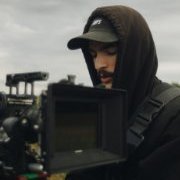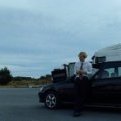-
Posts
2,101 -
Joined
-
Last visited
About Adam Frisch FSF

- Birthday 07/24/1971
Profile Information
-
Occupation
Cinematographer
-
Location
Los Angeles, USA
-
Specialties
Swedish cinematographer now in Los Angeles.
Contact Methods
-
Website URL
http://www.adamfrisch.com
Recent Profile Visitors
-
Love tungsten still. And on a few projects each year, where it fits, I try to use only tungsten lights, to stay sharp in the discipline. But admittedly, it is very hard sometimes to forego a SkyPanel or the mega-useful Astera tubes etc. My six favorite tungsten lights are, in no particular order: 1. Rifa 88. They keep telling me that a SkyPanel in a Chimera does the same thing, but it just doesn't... 2. Covered Wagons. If you have to do soft under lights and soft stuff from below/ground level, nothing even comes close. It's just an amazing look. 3. Maxi Brutes. Yes, the shadow pattern can be a little distracting, but nothing comes close to achieving the same "parallelleness". Single heads never replicate the sun in the same way as a broad multi source. Just used one the other month in Chicago, actually. 4. Molebeam. Extremely useful at times for those parallell beams that need to cut through a frame. 5. Mole "Big Eye" 10K. With its oversized fresnel lens, this is a lovely beauty light. Used to hang it right above lens, swap the bulb out for a 2K or a 5K globe, dim it slightly. Used it on tons of cosmetic commercials and music videos. 6. Mole Zip soft lights. My favorite is the 2K, but also the 4K. They're just delicious when dimmed down slightly, and so quick to use. Somehow the hood makes them spread less, without feeling "egg crated" like the SkyPanels do when you try to contain them.
-
https://www.youtube.com/watch?v=RmB6bR9Vf4s
-
- 3
-

-
Selling my set of Meyer-Görlitz FF lenses in PL-mount. 9 lenses in this set: 2x 29mm F2.8 (one is a Pentacon) 35mm F4.5 40mm F4.5 50mm F2.9 58mm F2 80mm F3.5 90mm F3.5 135mm F2.8 Beautiful rehoused set (by GL Optics) in 2 custom cases. Meyer-Görlitz known for their "bubble bokeh" look and high quality. They cover Full Frame throughout. Both the 29mm's and the 80mm have new iris:es that replaced the original 6-blades for rounder 12-blades. The Meyer-Görlitzes combine the old vintage look with a sense of German precision. Unique set - I heard a rumor about another set being converted, but this is the only one I know of in existence. Some lenses are a little bit softer than others (the 80mm being the softest and a beautiful close-up lens). A few film examples shot fully or partially with the Meyer's appear on my instagram - please check @adamfrischfsf Amazing "speaker cone" multi-color flares in many of them - again, see example on instagram videos. I would love to have kept them, but house improvements and taxes etc need to be paid. Lenses are at Camtec in Burbank, CA and I'm happy to show them to anyone who's interested. Thinking $65K for the set.
-
"If you have nothing nice to say, then don't say anything" is good advice. But sometimes you just can't help but to pick your jaw up from the floor... Why did the big name actors agree to do this? Walter Hill's legacy? I simply wasn't prepared for just how cheap this looks. It's like daytime soap opera or student film lighting and direction. It's sad, because I know so many great commercial DP's, struggling directors, writers etc who would kill it with a project like this, but are never ever given a chance to do features or long form. But this gets made and shot? https://youtu.be/-7EhBLbZwh0 PS. Read the comments on trailer.
-

Rental house recommendations (Los Angeles)
Adam Frisch FSF replied to Michael Helenek's topic in General Discussion
I'm a Camtec fan these days after having been at both Otto Nemenz and Panavision before. Camtec has their own lens department and mechanical shop, so have a great selection of modified lenses, uncoated, vintage etc. After Panavision and maybe now Keslow (that bought everyone), they for sure have the most eclectic and large lens library. And they're really nice people. Not always the lowest bidding one, but great equipment. If you want a good smaller rental place that can work with a really tight budget, I think T-Stop Rentals is a good option. Or Camerahouse. -
Spent the last 5 years doing mainly car commercials in the RA. Or "Arm car" as they prefer it these days (as they're very entrenched in old politics and fractions and want to distance themselves from the Russian heads...). I operate all my own stuff. I know a few operators that use wheels in the car, but the absolute majority use a joystick, myself included. Not really sure you can train for it, but when you're working up close and fast, it helps to keep the pan speeds up. I have quite high dampening as well, but that's a personal choice. Makes my abrupt operating look smoother. You kind of have to anticipate moves a bit - and you'll miss. I miss all the time. Car accelerated left and you thought it was going to break etc. Happens. The hardest ones, are the pretty common: start at front, over the top of the car (and turn camera 180 degrees without a 4th axis) and then nailing a low end symmetrical shot as the car accelerates away. Those are very hard and almost nobody nails them without at least few tries. Sometimes they just don't ever get nailed. I always try to discourage the use of them, because they're that hard. If you have to do them, start upside down and then turn image in post - at least then you don't have to try to nail the 180 turn at the top when you're looking down and have no reference except the roof of the car. Another tricky one is drifts in turns as you counter - they tend to get very fast in the last moments and easy to lose track of. But sometimes the messiness adds to the action and speed in those shots. Perfection isn't always the best for the shot. But to be honest, I'm not the best operator in the world either. I'm decent. I'm sure there are guys that can nail those shots much better than me, so if you have very technical stuff like that, don't be afraid to ask for a pro operator. You'll also find after awhile, that it's really hard to do any type of truly new or groundbreaking RA shots. They've all been done and frankly, most cars look good in three quarters, or 7/8's and that's where you end up to sell the sheet metal. Very few cars look good dead on or in straight profile - and with any city work, you'll always fight the wides and profiles and end up on a too wide a lens. Most cars kinda look bad on wide angles (there are a few exceptions). Hope this helps! RA work is fun though - keeps you on your toes and it's very dynamic! Never a dull day in the arm car...
-

Carol
Adam Frisch FSF replied to Kenny N Suleimanagich's topic in On Screen / Reviews & Observations
Meant to post about Carol already this summer, when I happened to see it on the plane back to LA from Europe, but life got in the way. I was blown away by how beautifully it was shot. It's stayed with me ever since as a real inspiration. Every frame is beautifully composed and lit, reminding me of some of the work of Saul Leiter in many ways. Obscured, veiled and through lace. The color palette, the PD and costume design - everything works together in a wonderful way. Even the few shots where obvious budget constrains forced Ed Lachman to make choices one would perhaps not normally do - like shoot up towards the cityscapes in NYC on a car scene on a freeway rather than level - and it adds this beautiful quality that really enhances it and makes it even more interesting. Amazing S16mm work. I can not think of a better shot S16mm film I've seen. -
It is no secret perhaps that David Watkin, BSC was gay. I mention this only because I actually think it influenced his cinematography, as it was rooted much more in swinging London, editorial and fashion, rather than staler coming-up-through-the-male-ranks. Towards the end of his life, he used to love to have young DP's over for lunch at his Brighton house. I think he just enjoyed the chats and hanging with young DP's that were interested in hearing his war stories. I got wind of this and sent him a letter where I asked if I could come talk cinematography over a cup of tea, as I was just up the coast in Hastings. I got the loveliest letter back from him, where he complained he had just had surgery or something and once he'd healed from that, I was most welcome to have lunch in Brighton! He would send me an invitation when he felt better. Unfortunately, a couple of moths later he was dead. I kept that letter for years, but somehow it got lost in the move to the US, which is a bummer. In any case, David Watkin was a fantastic cinematographer and anyone can learn a lot from his work. Very ahead of his time in many ways, with a modern approach to lighting that was at the time still very much mired in the old studio way of doing things. In many ways I think of him as the DP equivalent to Helmut Newton in stills. Not so much in style perhaps, but in that they both really renewed the medium and pushed it to something new.
-

Cinematographer? Fake it till you make it.
Adam Frisch FSF replied to Stephen Sanchez's topic in General Discussion
Let me tell you a true story that happened maybe 3 years ago: One early morning my agent gets a call from one of his newly signed shit-hot DP's - the guy everyone wants to book at the moment. The DP has pulled off the freeway and is having panic attack and can barely breathe. When he finally calms him down, it turns out he's on his way to hist first big job on a soundstage. "I've never lit anything in a studio, or even seen a built set before - I've just used natural light on location!". Now, that wouldn't have happened when I started. You simply didn't get these kinds of jobs unless you had a certain amount of experience. The 5D and YouTube generation changed that, because now, the creative director is the same age and his references are also music videos and YouTube stuff! I actually think there are great benefits to this potential fast-track-to-the-big-leagues, in some regards. It used to be (like it was for me), that if you started out shooting MV's, you could never in a million years get a commercial from that. It was just never done - seen as two different disciplines and if you did one, you did only that. No crossover was allowed. That's all out the window now. You do something cool, either a MV, an ad, or a short film, or an art film, and if it connects you can be on the biggest commercial of your life the day after. It's good that those barriers are gone. The bad thing, of course, is that you then sometimes get people that are clueless doing jobs way above their skill levels. And perhaps worse, that skills are no longer valued. It's a double edged sword. I'm not sure what's best. I certainly wouldn't want the restrictive stuff I had to deal with back then back. But then again, I would like to also live in a world where my 25 years of experience counts for something. -
Yes, it has gotten damaged somehow, probably by just ground radiation and being stored in a position where it created this repetitive pattern. But it's also worth remembering that this particular stock was well hated and was grainy already when it was brand new. Kodak discontinued it after just a few years and it must have been their shortest running stock. Worth noticing is also that sensitivity actually goes down - it's not just that the base fog increases. Exposed correctly, they still look underexposed, so they basically get less sensitive with time.
-
You might want to have a look at a few very rough tests I did with my old short ends. I deliberately chose the oldest stock I could find, a short end from 1996 that had been stored pretty badly and in room temp or hotter. I was looking at fog levels and grain mainly, so not a very sophisticated test setup. https://vimeo.com/231496214 Here I also tested the very short-lived 800ASA 35mm Kodak stock, and you can see it held up pretty bad. But you can also tell that both stocks respond well to over-exposure to suppress grain and fog. A rule of thumb is to add 1 stop for each decade of film age. https://vimeo.com/231494580 You could not use this kind of film for anything where a stable or professional outcome is needed. But you could certainly use it for shorts, experimental stuff or perhaps black and white stuff - there the grain and fog almost add's something.
-
Unfortunately, I don't think we're going back to work soon here in the US. Recent happenings leads me to believe this. Unionized filmmaking is at the moment uninsurable - and from what I can see it will remain so until governmental gap support formulates. There is no way this will resolve itself in the market sphere by itself.
-

Nykvist, Lighting Gear, & Generators
Adam Frisch FSF replied to Will Jacobs's topic in Lighting for Film & Video
Another DP that used a lot of Blondes and Redheads is/was Eduardo Serra ASC. He basically had a truckful of those and not much else. I won't deny that some of the newer lighting units like LED's are very useful, but at heart I'm a very old school lighter that likes to use old tungsten lights. On ever job I do I always bring Parcans (they are incredibly useful and very cheap), at least a few Mole zip softlights and usually one or two open face lights, too. With very basic and cheap units you can achieve a lot. -
Imranul Islam started following Adam Frisch FSF
-

How long do you think we're gonna be unemployed?
Adam Frisch FSF replied to Frank Hegyi's topic in General Discussion
I, unfortunately, think this will be a long time for all of us. 120000 IATSE members unemployed already here in the US. All freelancers. How long before they can no longer pay for their mortgages? How long for them to fall out of the union health care system (we need 400hrs/6month period to qualify). By May with no work, half of them are already there, most likely and it will snowball from there. 120000 unemployed IATSE








